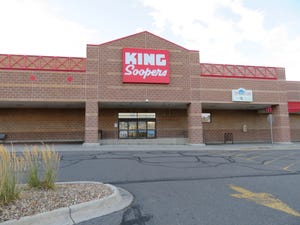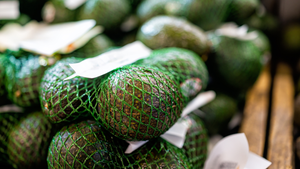QUALITY CONTROLQUALITY CONTROL
THERE WAS A TIME, not too long ago, when supply was low, prices were high and there was virtually no promotional activity to support organic produce; only a few consumers even knew what organic meant, so demand, quite naturally, was also low. Teagan Donovan, organic produce buyer/manager for Fairfield, Ohio-based Jungle Jim's, remembers the days when he first began buying organic produce. I'd look
June 1, 2007
LIZ PARKS
THERE WAS A TIME, not too long ago, when supply was low, prices were high and there was virtually no promotional activity to support organic produce; only a few consumers even knew what organic meant, so demand, quite naturally, was also low.
Teagan Donovan, organic produce buyer/manager for Fairfield, Ohio-based Jungle Jim's, remembers the days when he first began buying organic produce.
“I'd look at something and say, ‘That doesn't look very good,’ and someone would say, ‘Well, that's the way it's suppose to look. It's organic.’
Organic produce arrived so “unattractive, we would not put some of it out,” agreed Duane Wentz, produce specialist for Spokane, Wash.-based Yoke's Fresh Markets.
“Nowadays, when we put out organic produce, it looks as good as — and often even better than — conventional produce,” he continued. “Prices are also much more reasonable. Sometimes I can buy organic produce for less than what I pay for conventional produce. And the quality is great.”
What a difference a few years make. The implementation of national organic standards in 2002 not only brought consistency to the category, it defined the word “organic” for American consumers. It's become much easier for retailers to talk about the high quality, consistency of supply, greater variety and competitive pricing that make up today's organic produce industry.
“There's a steady flow, a consistent source of supply and a greater variety of suppliers,” said Terri Bennis, vice president of perishables for Kowalski's Markets, in St. Paul, Minn. “And organically grown produce today definitely has more eye appeal. I think the growers today realize that customers buy with their eyes. They are also doing a much better job in growing items of consistent sizes.”
Most supermarket retailers carrying organic produce report that the number of SKUs they carry and the amount of space dedicated to organic produce have doubled or tripled in the last three to five years, keeping pace with a similar surge in sales.
Typically, supermarkets have at least two or three ways of merchandising organic produce. Whereas five years ago, organic produce was generally merchandised in a segregated display clearly labeled organic, retailers have gained enough handling and merchandising experience to jazz things up a bit. Price Chopper, a Schenectady, N.Y.-based chain, began adding more than 1,000 new natural and organic items to the chain's 115 stores, integrating them into almost every section, including produce. Mona Golub, vice president of public relations and consumer services, said Price Chopper is now sourcing additional organic varieties “from all over the world.” They now carry more than 125 organic fruits and vegetables, using bright yellow-and-green signage to highlight organic selections. The graphics are incorporated into display barriers for loose produce that also keep conventional and organic items from commingling.
Neighboring chain Wegmans, in Rochester, N.Y., has also reached an integration threshold with its customers. As part of her regular online column, spokeswoman Mary Ellen Burris wrote to customers that the chain is gradually moving organic produce side by side with conventional product, category by category.
“It's our belief that consumer decisions are easier when all the choices can be seen in one place,” she stated. “A recent customer comment intrigued me: ‘At first this annoyed me, since I'd grown accustomed to everything organic being in one place. Then, as I shopped, I realized I really liked it; today I realized how nice it was to move from section to section (broccoli to apples to greens) and know immediately whether I had an organic option.’”
Burris said the chain is taking steps to protect the integrity of the organic produce items, as well as installing clear sign-age marking displays.
Out West, Yoke's carries an average of 70 SKUs of organic produce in all but one of its 13 stores. The size of the section varies, depending on market demographics and store size. The independent's newest unit in Sandpoint, Idaho, has the largest set: about 150 varieties, in a 40-foot department. Most organic produce sets range from 24 to 36 feet in newer stores.
“I hope we would have pretty much everything the customers would want,” said Wentz.
At Kowalski's Grand Market, organic produce buyer Bruce Opsegh said they probably carry twice as many SKUs today than they did five years ago.
“The market's vastly expanded, and you can find just about anything now that's grown organically: mangos, kiwi, snow peas, sugar snap peas, green beans,” he said. “It's not just the staples anymore. We carry over 200 SKUs. Our pricing has also come down, especially for whatever is in season.”
Kowalski's has tweaked a number of merchandising plans in produce. Today, some of the bagged and clamshell prepackaged organic products, such as strawberries and cherry tomatoes, are integrated, because “that seems to make shopping easier for our customers. We find they sell best when merchandised side by side to the conventional packaged produce.”
Bulk organic produce is merchandised in a segregated, four-deck wet case section, which averages 16 to 20 square feet, plus satellite displays. Total average square footage for organic produce is almost 60 square feet. Kowalski's uses bright green banners with the USDA's organic seal as well as the words “Natural Path” to highlight organic choices within the department. This year, Kowalski's is for the first time putting a big push behind organic fair trade banners. All advertising and marketing is focused on in-store events and regularly features organic produce in the store's bimonthly magazine, At Home with Kowalski's.
“That's our vehicle for educating consumers about the differences between organic produce and locally grown produce, or organic produce and conventionally grown produce,” said Bennis. “We always highlight a local organic farmer, and we try to highlight whatever is in season, and we print lots of recipes.”
Low-profile cases used to be the norm at Jungle Jim's. Now, as organic produce becomes a focal point, product is merchandised in a 48-foot run of multideck cases. Instead of a plain white background and shelves, the cases are black “so the produce really stands out,” said Donovan, the buyer/manager. Endcap displays are used for non-refrigerated organics like onions, tomatoes and bananas. These are typically placed directly across from the refrigerated cases.
Every week, Jungle Jim's runs at least two or three organic produce items on ad, which “we very seldom used to do. Now, however, we feel there's a growing awareness of organic and what organic means,” Donovan said.
Among the newer items that Jungle Jim's carries are organic refrigerated polenta, daikon radishes, microwavable sweet potatoes and a wide variety of refrigerated organic juices.
Even as the category continues to grow, supermarkets are continuing to experiment with ways to encourage shoppers to try organic fruits and vegetables. Experience has taught Donovan that organically grown bananas are a good place to start.
“Once they've tasted and bought organic bananas, you'll hear a lot of people talking about how good they taste and how well they hold up,” he said. “Then they start buying other types of organic produce.”
Packaged Organics
Sales of packaged organic produce are growing faster in conventional supermarkets than in natural food stores.
According to the most recent 52-week data from market research firm SPINS, dollar sales of packaged organic produce sold through natural food stores increased 14.5% to $172.2 million for the period that ended Jan. 27, 2007. Sales in conventional supermarkets increased 18.8% in that time to $656.6 million.
The fastest-growing packaged organic produce category in conventional formats is packaged fresh herbs, up 110% to $26.6 million. Next is packaged fresh-cut fruit, up 52.2% to $690,200, compared to a decline of 27.2% in natural food stores.
Both conventional and natural food stores are seeing strong gains with packaged organic whole fresh fruits, up 24.1% to $61.5 million in the natural segment and up 25.2% to $184.7 million in conventional supermarkets.
— LP
GOOD ADVICE
Retailers are trending toward integration, reflecting a higher degree of consumer acceptance.
Start organic produce programs with high-volume items like bananas or apples.
There are no more excuses for selling poor-looking organic produce.
Well-positioned displays of juices and ancillary items can drive traffic into the organic produce section.
Profit Centers
Conventional supermarkets sell more packaged organic produce today than do natural food stores
| NATURAL STORES | CONVENTIONAL STORES | |||
|---|---|---|---|---|
| Sales (M) | Change (%) | Sales (M) | Change (%) | |
| Packaged salad | $59.0 | 15.5 | $219.8 | 15.4 |
| Packaged fresh fruit | $61.5 | 24.1 | $184.7 | 25.2 |
| Packaged fresh vegetables | $32.9 | 2.3 | $178.2 | 11.6 |
| Packaged fresh-cut vegetables | $7.1 | -1.9 | $46.7 | 10.8 |
| Packaged fresh herbs | $11.8 | 13.1 | $26.6 | 110.6 |
| Packaged fresh-cut fruit | $0.5 | -27.2 | $0.7 | 52.2 |
| Total | $172.2 | 14.5 | $656.6 | 18.8 |
| NOTE: COVERS THE 52 WEEKS FROM JAN. 28, 2006, TO JAN. 27, 2007. CONVENTIONAL REFERS TO THE FOOD/DRUG/MASS CHANNELS, EXCLUDING WAL-MART. TOTALS REFLECT ROUNDING. SOURCE: SPINSSCAN NATURAL, SPINSSCAN CONVENTIONAL (POWERED BY ACNIELSEN SCANTRACK) | ||||
About the Author
You May Also Like




